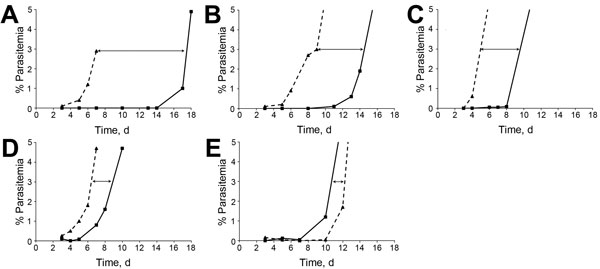Volume 21, Number 10—October 2015
Research
Induction of Multidrug Tolerance in Plasmodium falciparum by Extended Artemisinin Pressure
Figure 1

Figure 1. In vitro drug survival assays for Plasmodium falciparum. Representative curves for kinetic recrudescence of synchronous ring-stage parasites from F32-ART5 lineage (dashed lines) and F32-TEM lineage (solid lines) parasite cultures after a 48-h exposure to A) 11 μmol/L artemisinin; B) 62 nmol/L amodiaquine; C) 241 nmol/L mefloquine; D) 4 μmol/L pyrimethamine; and E) 7 μmol/L atovaquone. Differences in recrudescence between both parasite lines are indicated by doubled-headed arrows.
1Current affiliation: Universitas Gadjah Mada, Yogyakarta, Indonesia.
2Current affiliation: Institut Pasteur, Phnom Penh, Cambodia.
Page created: September 22, 2015
Page updated: September 22, 2015
Page reviewed: September 22, 2015
The conclusions, findings, and opinions expressed by authors contributing to this journal do not necessarily reflect the official position of the U.S. Department of Health and Human Services, the Public Health Service, the Centers for Disease Control and Prevention, or the authors' affiliated institutions. Use of trade names is for identification only and does not imply endorsement by any of the groups named above.